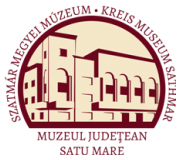Astaloş, Ciprian (szerk.): Satu Mare. Studii şi comunicări. Seria arheologie 28/1. (2012)
Bogdan Petru Niculică: Tre bronze sword of Costâna (Todireşti commune, Suceava county)
Bogdan Petru Niculică celt, with very flared edge and wave-shaped ornamentation, is dated to Ha B21. Also in Hallstatt B is dated the celt discovered between the two World Wars on the surface of the Early Hallstatt settlement of Vârvata - Cetăţuie (Pârteştii de Jos commune, Suceava county)22. On the right bank of Suceava, downwards of Costâna, at Mihoveni-CaWa Morii, where the Hallstatt pottery was found23, a bronze sickle of the hooked type was also identified24. In the hydrographic basin of Soloneţ river about 40 settlements belonging to the black channeled pottery horizon (Grăniceşti cultural group) were identified during surface researches, and among them a fortified settlement. M. Andronic, the author of the field researches in the specified areal, identified not less than 20 grouped and isolated tumuli, some of which could belong to the first Iron Age25. In the hydrographic basin of Ilişeşti brook, right-hand affluent of Suceava river, six Hallstatt settlements and four groups of tumuli are known26. For the Grăniceşti group in Suceava Plateau, A. László recorded, at the level of year 1994, not less than 25 discoveries, in which he also included bronze objects. On the contrary, in 2008, M. Andronic showed that there were inventoried more than 100 spots throughout historical Bucovina province27. In Suceava County, close to Costâna, there were researched several archeological sites which also produced pottery dated to teh Early Hallstatt, out of which mention should be made of: Mihoveni-Ca/i/a Morii (Şcheia commune)28, Todireşti-La Nuci (Todireşti commune)29 and Vârvata-Cetăţuie (Pârteştii de Jos commune)30. The pottery in these settlements belongs to the Grăniceşti cultural group, as defined by Professor Attila László31. All the above settlements, together with the bronze discoveries known so far, provide us with a more vigorous and nuanced view on the habitation dynamics of the first Iron Age in the Suceava Plateau. Analogies, dating Regarding the chronological and typological attribution of the sword of Costâna we should take into account the elements that show us the relation to other discoveries: ricasso, the shape of the handle guard, the shape of the blade and the cross-sections, and also the lack of rand from the rod / peduncle of the handle. In T. Baders monographic study on the bronze swords of Romania, there are several swords showing similitudes to our item. The most adequate analogies are those found within full handle sword group (Vollgriffschwerter) more precisely the types Liptau and cup-hilted32. In our view, the item of Costâna is morphologically close to the sword of Liptau type discovered at Odorheiu Secuiesc (Harghita county) which shows several incised lines on the blade33 and the fragment of Liptau sword of Şimleul Silvaniei (Sălaj county)34. Among the cup-hilted swords, mention should be made of the one of Turda (Cluj county)35. We showed above that in the Suceava Plateau, at Corni (Liteni commune, Suceava county), on the right bank of Siret river, there was discovered a handle of a sword of the Liptau type36; thus, we have a starting point in our dating, meaning that in the northeast of Romania the existence of this type of sword is demonstrated. Also, in northwestern Ukraine (Galicia), Liptau swords or cup-hilted 21 Ignat 1981, 141, no. 8, fig. 5/5; Andronic 1997, 29; Ignat 2000, 64, no. 28, fig. 20/28. 22 Dressier 1960, 13-18; Ignat 1993, 375, no. 2, fig. 1/6; Andronic 1997, 59, no. 94; Ignat 2000, 62, no. 26 fig. 20/26; Andronic 2008, 162, PI. 13/18; Niculică 2011, 389, 397. 23 Ursulescu/ Batariuc 1978, 89-91, fig. 9/7. 24 Niculică 1999,215-220. 25 Andronic 1997, passim. 26 Andronic 2010,192-195. 27 Andronic 2008, 160. 28 Ursulescu/ Batariuc 1978. 29 Andronic 2011. 30 Dressier 1960, 16-18; Niculică 2011. 31 László 1976b, 57-75; László 1983-1984, 65-84; László 1994, 48-104. 32 Bader 1991, 128-129, no. 318, Taf. 32/318, 33/318; 130-131, no. 322, Taf. 34/322, 35/322; 143, no. 340, Taf. 38/340, 39/340. 33 Bader 1991, 128-129, no. 318, Taf. 32/318, 33/318. 34 Bader 1991, 130-131, no. 322, Taf. 34/322, 35/322. 35 Bader 1991, 143, no. 340, Taf. 38/340, 39/340. 36 Ignat 1981, 139-140, no. 2, fig. 4; Bader 1991, p. 138-139, no. 332, Taf 35/332; Taf 36/332; Ignat 2000, 102, nr. 67, fig. 30. 240
